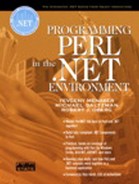Hello, World (Component Version)
In terms of object-oriented programming, C# and the other .NET languages are nice, but the real innovation of .NET comes from the ease with which components can be created. A component can be thought of as a piece of black-box functionality, and different components can be hooked together as long as the proper external interfaces are observed. Components of a stereo system are a good example. You can plug in different speakers, and they will still work, provided the speakers use the standard interface.
In software there have been a number of different component architectures. Before .NET the leading component architecture on Microsoft systems was the Component Object Model (COM), which did indeed provide black-box reusability of software modules written in different languages. But COM requires either the program (in languages like C++) or the programming environment (in languages like Visual Basic) to implement the plumbing code required for interoperability. COM is complex and places a substantial burden on the programmer.
The beauty of .NET is that the .NET Framework itself transparently provides all the needed plumbing, and creating a .NET component out of a class is as easy as compiling as a special kind of project, a class library. Once built, other programs can call this class library merely by obtaining a reference to it. These other programs can be in any .NET language, including PerlNET.
Hello, World Class Library
As an example of creating a class library in C#, we will create a component version of our Hello class. A completed solution is in HelloLib. The source files are identical. We just compile them in a different way. To build the class library Hello.dll at the command line, use the /t:library switch (short for /target:library).
csc /t:library Hello.cs
To use the class library, you need to obtain a reference to it, which you can do when you build the EXE program by using the /r switch (short for /reference).
csc /out:TestHello.exe /r:Hello.dll TestHello.cs
These two compile commands are provided in the batch file build.bat.
A PERL CLIENT PROGRAM
You can easily create a client program TestHello.pl that uses this class library. See the folder HelloPerl. For convenience we have the C# class source file Hello.cs and the Perl file TestHello.pl together in the same folder, along with a batch file build.bat that builds both. (We also provide a Visual Studio solution.) Here is the Perl script.
#
# HelloPerl.pl
#
use strict;
use namespace "System";
use PerlNET qw(AUTOCALL);
my $obj = Hello->new();
$obj->SayHello();
$obj = Hello->new("Goodbye, world");
$obj->SayHello();
$obj->{Greeting} = "Brave New World";
Console->WriteLine($obj->{Greeting});
You may wish to review the Chapter 10 discussion of using .NET components in PerlNET programs.
In the rest of this appendix we will stick strictly to C# programs. As an exercise, you may wish to rebuild the C# classes as class libraries and create PerlNET programs to exercise them.
